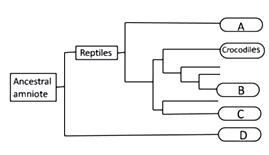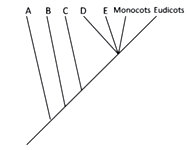 Multiple Choice Questions
Multiple Choice QuestionsThe following table shows selected characters used in analyzing the phylogenetic relationships of four plant taxa:
| Taxon | Xylem or Phloem | Wood | Seed | Flowers |
| T1 | + | - | - | - |
| T2 | + | + | + | + |
| T3 | + | + | + | - |
| T4 | - | - | - | - |
Taxa T1, T2, T3 and T4 are respectively:
Ferns, Oaks, Pines, Hornworts
Oaks, Pines, Hornworts, Ferns
Hornworts, Pines, Oaks, Ferns
Ferns, Pines, Oaks, Hornworts
Given below are the main characteristics of a few mammalian orders. Match the names of the animals with the characteristics of their orders:
A. Hooves with even number of toes on each foot, omnivorous.
B. Teeth consisting of many thin tubes cemented together, eats ants and termites.
C. Opposable thumbs, forward facing eyes, well developed cerebral cortex omnivorous.
D. Hooves within odd number of toes on each foot; herbivorous
(i) Tapir; (ii) Lemur; (iii) Aardvark; (iv) Pig
Choose the correct combination
A - (iii); B - (iv); C - (i); D - (ii)
A - (i); B - (iv); C - (ii); D - (ii)
A - (iv); B - (iii); C - (ii); D - (i)
A - (iv); B - (iv); C - (i); D - (ii)
Match the five (A - E) group of organisms with their correct taxonomic rank (i - v) given below:
| Group | Taxonomic group |
| A. Crustacea | (i) Order |
| B. Hominidae | (ii) Domain |
| C. Dermaptera | (iii) Class |
| D. Ctenophora | (iv) Phylum |
| E. Archaea | (v) Family |
A - (iii); B - (i); C - (v); D - (iv); E - (ii)
A - (i); B - (ii); C - (iii); D - (iv); E - (iv)
A - (iv); B - (iii); C - (ii); D - (i); E - (v)
A - (iii); B - (v); C - (i); D - (iv); E - (ii)
The following are matches made between adult animals and their larval forms:
A. Copepods - Nauplius
B. Sea cucumber - Zoes
C. Sea urchin - Echinopleuteus
D. Crabs - Auricularia
E. Star fish - Bipinnaria
F. Brittle star - Ophipleuteus
Which one of the combinations below reflects INCORRECT matches?
A, C, E
B and D
B only
F only
The phylogenetic tree of amniote vertebrates is given in the following diagram

The groups labelled A, B, C, and D are
A - Snakes; B - Turtles; C - Birds; D - Mammals
A - Snakes; B - Turtles; C - Mammals; D - Birds
A- Turtles; B - Birds; C - Snakes; D - Mammals
A - Birds; B - Turtles; C - Snakes; D - Mammals
Following is a cladogram of the major taxonomic groups of the angiosperms:

Group A-E represent respectively:
Astrobaileyales, Nymphaedales, Amborellales, Chloranthaceae, Magnoliids.
Amborellales, Astrobaileyales, Nymphaedales, Magnoliids, Chloranthaceae
Amborellales, Nymphaedales, Astrobaileyales, Chloranthaceae, Magnoliids
Amborellales, Nymphaedales, Chloranthaceae, Magnoliids, Astrobaileyales
Which of the following is the correct match of the algal group with its food reserve?
| Algal group | Carbohydrate Reserve |
| A. Bacillariophyceae | i. Oil |
| B. Xanthphyceae | ii. Floridean starch |
| C. Phaephyceae | iii. Laminarin |
| D. Rhodophyceae | iv. Chrysolaminarin |
| v. Starch |
A - (iv); B - (i); C - (iii); D - (ii)
A - (ii); B - (i); C -(iii); D - (iv)
A -(iv); B - (i); C - (ii); D - (v)
A - (i); B - (v); C - (iii); D - (ii)
According to 2014 IUCN Red List, which of the following vertebrate classes has the largest percentage of threatened species?
Mammals
Birds
Reptiles
Amphibians
Which one of the following gymnosperm phyla produces motile sperms, bears ovulate and microsporangia cones on separate plants and has fleshy, coated seeds?
Coniferophyta
Cycadophyta
Ginkgophyta
Gnetophyta
Identify the correct match between the animal (flatworm, earthworm, roundworm) and its body cavity type (acoelomate, coelomate, pseudocoelomate):
Roundworm - pseudocoelomate; Earthworm - acoelomate; Flatworm - coelomate
Roundworm - acoelomate; Earthworm - coelomate; Flatworm - acoelomate
Roundworm - pseudocoelomate; Earthworm - coelomate; Flatworm - acoelomate.
Roundworm - coelomate; Earthworm - pseudocoelomate; Flatworm - acoelomate
